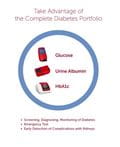Point-of-Care Testing (POCT) – A Way to Achieve Operational, Clinical and Economic Benefits
Point-of-care testing has been found to have a positive impact on diabetes management, and studies have described an improvement in patient satisfaction and glycemic control as a result of immediate feedback to the patient. By providing immediate results, reducing wait time compared to the central lab, and with potential to reduce medical costs by allowing better glycemic control and more rapid medication adjustments, POCT, or near patient testing, can lead to operational, clinical and economic benefits for the patient and healthcare provider.
Benefits with POCT
• Operational – reduced staff time, fewer orders to the lab, fewer patients lost to follow-up
• Clinical – increased patient understanding, faster implementation of medications modification , lower HbA1c levels
• Economic – fewer phone calls, less appointments, increased patient satisfaction
Point-of Care Testing offers reduced turnaround time and may promote improved operational efficiency. Implementation of POC can significantly improve clinical operations with cost reductions through improved practice efficiency.
In 2014 Crocker et al investigated how POC testing may affect operational costs using cost and revenue analysis. Following implementation of POC testing, a decrease in follow-up phone calls and letters by 89% and 85% respectively (P<0.0001 and P<0.0001) and a 61% decrease in patient revisits (=0.0002) was demonstrated. Estimated testing revenues exceeded expenses by USD6.62 per patient and potential cost savings from improved efficiency were USD 24.64 per patient suggesting that POC testing can significantly improve clinical operations with cost reductions through improved practice efficiency compared to central lab.
Advantages of POC testing
• Reduces overall turnaround time of diagnostic testing allowing physicians to implement treatment immediately
• Shorter patient length of stay and reduce anxiety since waiting times are reduces
• Reduces pre- and post analytical errors. Eliminates sample transportation/ degradation, and sample mix-up. Traditional lab testing involve multiple preparation steps by multiple persons with increased possibility of introducing pre- and post analytical errors
• User-friendly instruments allowing nontechnical/nonlaboratory staff to operate instruments Convenient for clinicians since testing can be performed quickly, and results are readily available.
• Patient-friendly Small sample volume which minimize or eliminates risk of hospitalized acquired anemia due to frequent sampling
• Ability to test alternative sample types (capillary, urine etc.)
• Decreases laboratory overload Allow labs to concentrate on more complicated tests, releasing more time in their schedule and cutting down on wait times
• Immediate feedback of HbA1c results improve glycemic control Studies have confirmed that immediate feedback of HbA1c results improve glycemic control in patients with type 1 and insulin-treated type 2 diabetes mellitus
How Can Point-of Care Testing Help?
Several studies suggest that POCT is beneficial for HbA1c testing in multiple areas. Outcomes suggested patients had greater understanding and were more satisfied with the state of their disease and treatment, and had better glycemic control. Improved operational efficiencies, better care for under-privileged populations and increased compliance with ADA testing frequency have also been observed in studies investigating POC testing.



